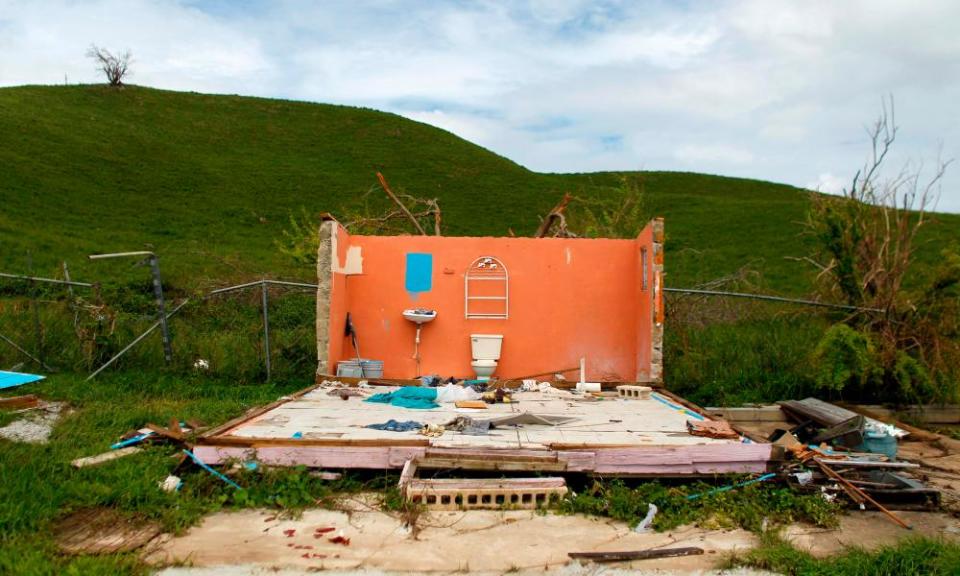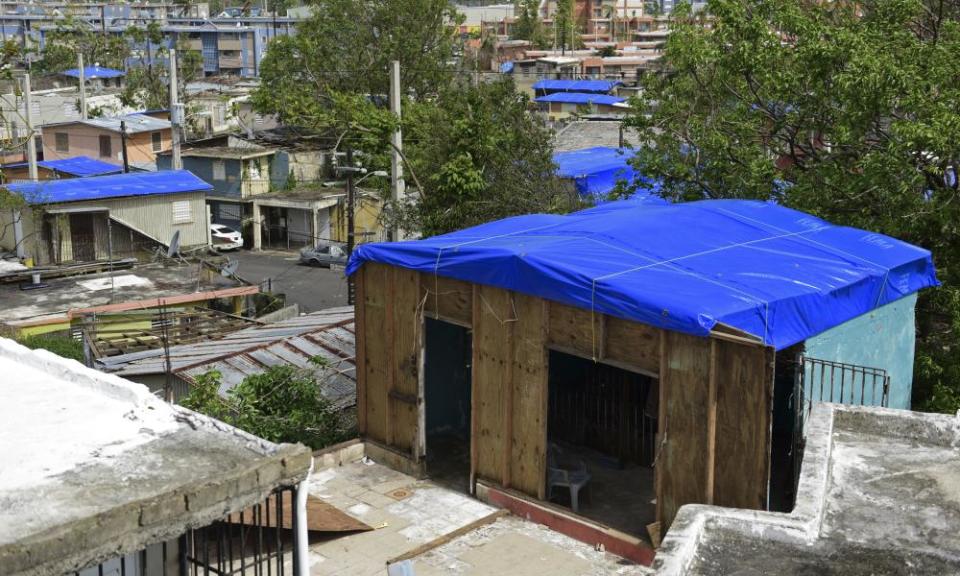Puerto Ricans face rain and floods in wrecked homes still without roofs
The distribution of tarpaulins, a standard emergency aid response, has not happened smoothly in Puerto Rico – leaving many braced against the elements

Of all the basic necessities still missing for Puerto Ricans more than a month after Hurricane Maria devastated the island, one is almost immediately obvious: the lack of shelter.
In neighborhoods across Puerto Rico, particularly outside the capital San Juan, many residents with damaged roofs have struggled to get even the most threadbare of defenses against the elements.
The distribution of tarpaulins, considered a standard first emergency response by aid workers, has not happened smoothly in Puerto Rico. While there is no firm estimate of houses with missing or damaged roofs, more than 230,000 dwellings in Puerto Rico were hit by the hurricane.
“The tarps should be handed out like candy to everyone and the fact they aren’t is crazy,” said Katia Avilés-Vázquez, a university lecturer who has helped with community recovery efforts.
Fema said it has provided 65,000 tarpaulins to local authorities to distribute and has 100,000 more in a warehouse. Samaritan’s Purse, an NGO, said it has given out 42,000 covers.
But many people still are without any shelter over their heads.
Ramón Rosario, a spokesman for Puerto Rico governor Ricardo Rosselló, acknowledged there has been a problem in getting enough tarpaulins to affected Puerto Ricans.
The tarps should be handed out like candy to everyone and the fact they aren’t is crazy
Katia Avilés-Vázquez, recovery volunteer
“It has been a priority of the government to save lives and keep the people safe,” he said. “The federal government has informed that there have been problems with the production of tarpaulins due to the emergencies in Texas and Florida. There’s no doubt that we need more tarpaulins because our estimate is that 250,000 houses suffered partial or complete damages.”
A Fema spokesperson, however, said there was not a shortage. “We don’t have a shortage of tarps, if they need more, we will bring more. Every mayor knows Fema has tarps. If survivors don’t know to go to local officials for them, that could be challenging.”
In one area, Toa Baja, a municipality near the northern coast that is a 30-minute drive west of San Juan, every other house is without any sort of roof.
Toa Baja still has the appearance of a place that Maria ransacked a few days ago. At least eight people from here died during the hurricane. Huge piles of debris and rubbish are strewn in the streets, power lines droop down from snapped poles.

Mud cakes the walls of everything, including the interior of Marta Pacheco Matías’s house. The upstairs is completely open to the elements, the roof replaced by the blue sky. When it rains, water seeps throughout the house.
“I’m worried because I’m alone and when it rains all the water gets in,” said Pacheco Matías, a diminutive woman who worked most of her life as a janitor. “I’m surprised they’ve taken this long but I can’t do anything. I have to wait. They said they would come.”
Everything is sodden and brown smears from the flood water are everywhere. Pacheco Matías sleeps on an inflatable mattress in the corner of her kitchen, wearing her one set of usable clothes.
Across the street, a man on dialysis is in the same situation. His neighbor has a number of tarpaulins her daughter bought for her from the hardware store but they are flimsy and often leak.
We have been on the list for a tarp for three weeks but no one has come to our house or called
Gigi Paonessa, San Juan resident
Outside, the local authorities in Toa Baja have arranged for beaming women in white T-shirts to walk through the devastated streets to offer cupcakes, coloured in the red, white and blue of the Puerto Rican flag, to incredulous residents.
The army corp of engineers, which has been installing the sturdier blue roofs, has visited the area and nailed notices to several houses. But no one knows if and when they will return, nor how to contact them.
Meanwhile in San Juan, where the territory’s government is based, tarpaulins are being sold at inflated rates.
The roof of Gigi Paonessa’s house was decapitated by Maria and she was only able to get a tarpaulin a week later after her sister paid $125 for one from a hardware store. Two other tarpaulins were donated by friends and Paonessa and her sister, who both live in the house with their grandmother, installed all three after watching a tutorial on YouTube.
Two weeks ago, strong winds blew away one of the tarpaulins, leaving rain to flood into the house unhindered, ruining most of the family’s possessions. Paonessa said mold from the flooding is making her sick.
“It’s horrible,” Paonessa said. “Every day is the same, for more than 40 days. It’s like my life is frozen. I don’t see progress, it doesn’t seem like the government is doing the right thing. We have been on the list for a tarp for three weeks but no one has come to our house or called. Nothing. There’s no help. Fema is here but there seems to be no communication.”
It’s been six week since Maria and it continues to rain on the uncovered houses of Puerto Rico.

